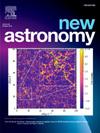用激光干涉仪空间天线预测PSR J0737-3039引力波的可探测性:四极逼近方法
IF 2.1
4区 物理与天体物理
Q2 ASTRONOMY & ASTROPHYSICS
引用次数: 0
摘要
引力波(GWs)是引力物理学的重要组成部分。在双星系统中,它是通过轨道能量损失发射的。在本文中,我们探索了激光干涉仪空间天线(LISA)对来自PSR J0737-3039的引力波的可探测性,这是已知的第一个双星脉冲星系统。该系统位于距离地球1150秒差距左右,轨道周期为~ 2.45 h,倾角为87°,使其成为测试引力物理的理想候选者。我们使用轨道频率规则将系统的GW频率近似为~ 2.26 × 10−4 Hz。我们使用四极公式(多极展开的一部分)来估计计算出的GW应变(h✕~ 4.8702×10−23和h+ ~ 4.6656×10−22)。应变幅值落在LISA探测器噪声曲线以下。我们提供了可能的解释,包括臂长和加速度噪声,同时提出了提高LISA灵敏度的方法。这些方法包括Noise2Noise算法和安装谐振检测器的可能性。本文章由计算机程序翻译,如有差异,请以英文原文为准。
Predicting the detectability of gravitational waves from PSR J0737–3039 with the laser interferometer space antenna: A quadrupole approximation approach
Gravitational waves (GWs) are an important component of gravitational physics. In a binary system, it is emitted through orbital energy loss. In this paper, we explore the Laser Interferometer Space Antenna (LISA)’s detectability of gravitational waves from PSR J0737–3039, the first known binary pulsar system. The system is located around 1150 parsecs from Earth, with an orbital period of ∼2.45 h and an inclination angle of 87°, making it an ideal candidate for testing gravitational physics. We approximated the GW frequency of the system to be ∼2.26 × 10−4 Hz using rules of orbital frequency. We used the quadrupole formula, a part of the multipole expansion, to estimate that the calculated GW strains (h✕ ∼ 4.8702×10−23 and h+ ∼ 4.6656×10−22). The strain magnitudes fall below the detector noise curve of LISA. We offer possible explanations for this, including arm length and acceleration noise, while proposing methods to enhance LISA’s sensitivity. These methods include the Noise2Noise algorithm and possibility of the installation of resonant detectors.
求助全文
通过发布文献求助,成功后即可免费获取论文全文。
去求助
来源期刊

New Astronomy
地学天文-天文与天体物理
CiteScore
4.00
自引率
10.00%
发文量
109
审稿时长
13.6 weeks
期刊介绍:
New Astronomy publishes articles in all fields of astronomy and astrophysics, with a particular focus on computational astronomy: mathematical and astronomy techniques and methodology, simulations, modelling and numerical results and computational techniques in instrumentation.
New Astronomy includes full length research articles and review articles. The journal covers solar, stellar, galactic and extragalactic astronomy and astrophysics. It reports on original research in all wavelength bands, ranging from radio to gamma-ray.
 求助内容:
求助内容: 应助结果提醒方式:
应助结果提醒方式:


